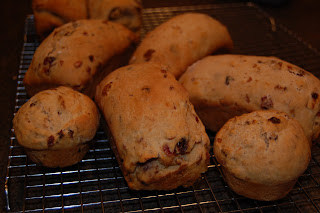
So, I’ve been negligent in posting for the last couple of weeks, but now I’m back on the band wagon.
I did a foccica about three weeks ago, but that was a remake of something I did while I had my wisdom teeth removed. Now I’ve moved on to the Italian loaf.
This was one loaf I was familiar with. Like the French, Italian is the other basic loaf that I make a lot. I say basic in only that it’s not a complicate recipe. It’s essentially the same as the French, but with the addition of a fat, in this case, olive oil. And I don’t mean Popeye’s girlfriend.
Italian is a softer loaf because of the fat, and because of this, I tend to make buns or rolls using this recipe.
In my case this week however, I believe I added too much water, and as you can see, that didn’t help with the shape.

Since there was so much hydration the dough spread out, instead of up. It tasted great, and with the use of a pre-ferment biga, I was able to draw out a lot of flavor. I just didn’t get the torpedo shape that I wanted. Next time I do this, I have made notes and I will incorporate either more flour, or less water to firm up the dough.
This week brings us to Kaiser Rolls. Alas my search for a Kaiser Roll stamp was fruitless and I was relegated to ordering it from Amazon. So, we move on to another recipe for this week, Lavash Crackers.
Lavash crackers seemed kind of weird. After all, this is a bread blog. I should be making bread. But, it’s in the book, so of course I’m doing it. Lavash is also called Aremenia flatbread, has Iranian roots and eaten throughout the middle-east.
The recipe is the same, but the oven it’s cooked in or how flat it’s rolled might be dictated by the culture you are from. The key to this crisp cracker is to roll it out paper thin. It would seem that I didn’t roll it out thin enough as some of the pieces are kind of doughy. Well, it was fun to put the toppings on and now I have a new cracker to use on my friends for our party.
Party on Wayne, Party on Garth.
Next week, Light Wheat bread.
 This is not your store's "Wonder bread." This style of dough has many uses beyond that of just a loaf bread. One could make dinner rolls, hamburger buns and hot dog buns. It's often referred to as milk dough because in most version the hydration is primarily from fresh milk (or powdered milk and water).
This is not your store's "Wonder bread." This style of dough has many uses beyond that of just a loaf bread. One could make dinner rolls, hamburger buns and hot dog buns. It's often referred to as milk dough because in most version the hydration is primarily from fresh milk (or powdered milk and water). 


 In some areas of the country, not here of course, this bread is called Hawaiian bread, but even then most of the time Hawaiian's give credit to the Portuguese for this big, soft, sweet, round pillow of a loaf. I cannot imagine making a sandwhich from this bread, but according to the text it's a very popular bread to do so. The distintive aspect of this bread, besides the lemon and orange extracts is the flavor the powdered-milk imparts. I can't say I tasted the powdered-milk, but the extracts made this bread wonderful.
In some areas of the country, not here of course, this bread is called Hawaiian bread, but even then most of the time Hawaiian's give credit to the Portuguese for this big, soft, sweet, round pillow of a loaf. I cannot imagine making a sandwhich from this bread, but according to the text it's a very popular bread to do so. The distintive aspect of this bread, besides the lemon and orange extracts is the flavor the powdered-milk imparts. I can't say I tasted the powdered-milk, but the extracts made this bread wonderful. 





























